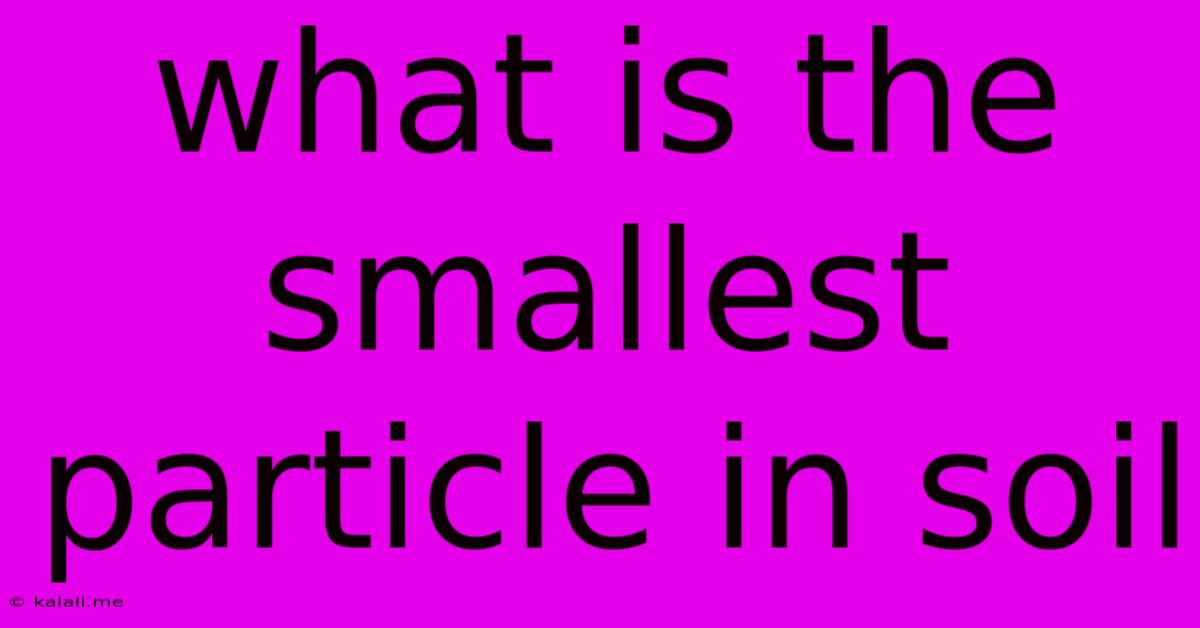What Is The Smallest Particle In Soil
Kalali
Jun 14, 2025 · 3 min read

Table of Contents
What is the Smallest Particle in Soil? Delving into the Microscopic World of Soil Composition
Understanding the fundamental building blocks of soil is crucial for anyone interested in agriculture, environmental science, or geology. While we often think of soil as dirt, it's a complex mixture of diverse components. This article dives deep into the question: what is the smallest particle in soil? The answer isn't as straightforward as you might think. It depends on what level of detail you're examining. This exploration will cover everything from the largest components down to the truly fundamental particles.
From Pebbles to Clay: The Hierarchy of Soil Particles
Soil is a heterogeneous material, meaning its composition varies greatly depending on location and geological history. However, we can categorize soil particles based on their size:
- Gravel: The largest particles, ranging from 2 to 75 millimeters in diameter. These are easily visible to the naked eye.
- Sand: Particles ranging from 0.05 to 2 millimeters. They are gritty to the touch and can be individually seen.
- Silt: Particles between 0.002 and 0.05 millimeters. They feel smooth and powdery.
- Clay: Particles smaller than 0.002 millimeters. These are too small to see without a microscope. Their tiny size gives them unique properties, influencing water retention and nutrient availability.
This classification system, the USDA soil texture classification, helps us understand the physical properties of soil. However, we haven't reached the smallest particle yet.
Beyond the USDA Classification: Exploring the Mineral Structure
Clay particles, while tiny, are not the ultimate building blocks. They are composed of minerals, primarily phyllosilicates, which are sheet-like structures. These sheet structures are made up of:
- Silicon-oxygen tetrahedra: These are the fundamental building blocks of many silicate minerals. They consist of a silicon atom surrounded by four oxygen atoms.
- Aluminum-oxygen octahedra: These structures, common in clay minerals, consist of an aluminum atom surrounded by six oxygen or hydroxide ions.
The arrangement of these tetrahedra and octahedra determines the specific type of clay mineral (kaolinite, montmorillonite, illite, etc.). These minerals are themselves composed of individual atoms bonded together.
The Smallest Particle: Atoms and Ions
Finally, we arrive at the smallest components: atoms and ions. These are the fundamental units of matter. Atoms are made up of a nucleus (containing protons and neutrons) and orbiting electrons. Ions are atoms that have gained or lost electrons, carrying an electrical charge. These atoms and ions are held together by chemical bonds to form the mineral structures within clay particles.
Conclusion: A Multi-Level Answer
So, the "smallest particle in soil" depends on your perspective. From a textural standpoint, clay particles are the smallest. But at the chemical level, the smallest units are the atoms and ions that compose the mineral structures within those clay particles. Understanding this hierarchy is crucial for comprehending soil properties, fertility, and the intricate processes happening within this vital natural resource. Further research into soil science can unlock a deeper appreciation for the microscopic wonders that underpin our terrestrial ecosystems.
Latest Posts
Latest Posts
-
Whats The Square Root Of 288
Jun 15, 2025
-
Population Of Scheduled Caste In India
Jun 15, 2025
-
Which Of The Following Materials Is Considered A Conductor
Jun 15, 2025
-
How Do The Bhaktis And Sufis Compare
Jun 15, 2025
-
Which Of The Following Statements About Computer Networks Is True
Jun 15, 2025
Related Post
Thank you for visiting our website which covers about What Is The Smallest Particle In Soil . We hope the information provided has been useful to you. Feel free to contact us if you have any questions or need further assistance. See you next time and don't miss to bookmark.